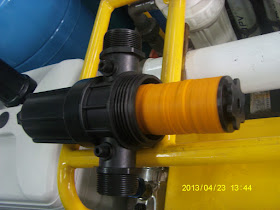
Water And Pregnancy
While it is always a good idea to keep the
body hydrated, there are certain times when changes in the body call for more
water.
One of these times is during pregnancy.
Water can be the answer to alleviating many
side effects of pregnancy, aid in preparing the body for these physiological
changes, and just overall make mommy and baby healthier.
Water is an important part of pregnancy. The
fluid acts as the body's transportation system, and
Also, flushing out the system and diluting
urine with water prevent urinary tract infections, which are common in
pregnancy.
Perhaps the biggest reason to drink water is
to keep the body hydrated. Dehydration in pregnant women can be very
serious.
 Hormones (gotta love those hormones!) change
the way women store water during pregnancy, so they begin to retain
water, and drinking plenty of water combats that.
Hormones (gotta love those hormones!) change
the way women store water during pregnancy, so they begin to retain
water, and drinking plenty of water combats that.
Much of that water is used in the amniotic
sack. Amniotic fluid alone needs to replenish itself every hour by using
roughly a cup of water stored in the body.
Replacing that water will ensure the fetus is
protected within the womb.
Since the blood volume increases to nearly
double by the eighth month of pregnancy, it is necessary to drink even more
water to compensate. Thicker blood can lead to hypertension and other
cardiovascular problems.
 Because dehydration can cause contractions,
lack of water in the third trimester can also cause premature labor. Premature
labor can have many health risks to the newborn baby.
Because dehydration can cause contractions,
lack of water in the third trimester can also cause premature labor. Premature
labor can have many health risks to the newborn baby.
In some cases, premature labor were stopped
simply by giving the mother enough water to re-hydrate her body.
Common pregnancy
discomforts that water may play a role in:
- Fatigue - Drink water throughout the day so
your urine is light colored – Water’s hydraulic cycle
- Hormone regulation & Headaches -
Water’s role in chemical reactions delivery and transport
- Upset stomach, heartburn, ulcers &
constipation – Water’s role in digestion
- Leg cramps, swelling, dizziness and
hypertension – Water’s role in fluid regulation and retention
Joint Pain – Water’s
role in lubricating the joints
Pregnant women should
be sure to drink at least eight 8-ounce glasses of water each day, which is in
addition to the normal intake of other recommended foods.
 The benefits of drinking water during
pregnancy include healthier skin, less acne, washing away of unnecessary
sodium, less chance for pre-term labor or miscarriage and better bowelmovements.
The benefits of drinking water during
pregnancy include healthier skin, less acne, washing away of unnecessary
sodium, less chance for pre-term labor or miscarriage and better bowelmovements.
Drinking water can, believe it or not, also
help preventing the nausea known as morning sickness, as doctors recommend
drinking plenty of fluid between meals.
Not only is the amount of water important but
also the quality of the water being drank is just as important.
Chlorine and other contaminants are often found
in tap water and even in some bottle water brands. The fetus may be sensitive
to the contaminants in unfiltered water which may pose a risk to their
development.
Point of use filtration systems are the only
way to ensure pure contaminant-free drinking water.
Drinking water for health benefits of the
mother and baby are evident.
Doctors, in fact, ask mothers to steer clear
of diuretics like caffeine and alcohol, so water is the obvious
alternative for fluid intake.
Also, since doctors often 'prescribe'
exercise in pregnant women, fluids will be lost through perspiration. As
we know, pregnant or not, those fluids also need to be replaced.
RELATED POSTS:.
.
.
.
.
.
.
CLICK HERE . . .
.
.
.
.
CLICK HERE . . .
.
CLICK HERE . . .
CLICK HERE . . .
.
.
CLICK HERE . . .
.
CLICK HERE . . .
.
.
 |
 |
| GS Series Submersible Pump |





































